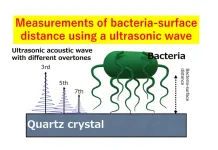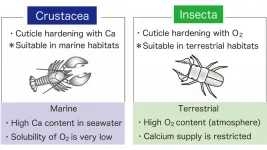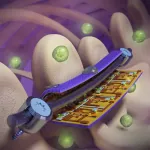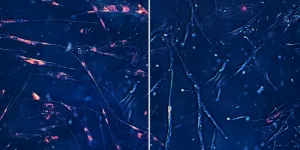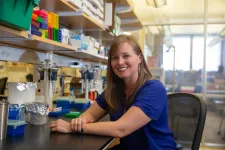(Press-News.org) The biofilm-forming bacteria E. coli adheres firmly to hydrophobic and hydrophilic protein-adsorbing self-assembling monolayers (SAMs) and weakly to hydrophilic protein-resisting SAMs, uncovered a recent study by Tokyo Tech researchers. These findings on how surface chemistry can influence the adhesion of bacterial cells and, in turn, biofilm formation could open doors to bacteria-resistant surfaces and antibiofouling coatings for biomedical and industrial devices.
Bacterial biofilms are like a double-edged sword. On one hand, they have proven valuable for electricity generation and degradation of toxic materials in water and soil but on the other hand, they are a nuisance when formed inside drinking water pipes, on contact lenses and on biomedical devices. To form biofilms, the bacterial cells first attach to the surface of materials via weak and reversible bonds. Once these bonds mature, the cells release polymeric substances that result in stable and irreversible biofilms.
Decoding the mechanism underlying the irreversible biofilm formation and its relation to the surface chemistry is key to unlocking biofilm prevention technologies. Over the years, scientists have proposed various techniques to narrow down the types of surfaces bacterial cells tend to adhere to. Unfortunately, the influence of surface chemistry and surface topography on biofilm formation have remained ambiguous.
Against this backdrop, a team of researchers led by Associate Professor Tomohiro Hayashi from Tokyo Institute of Technology (Tokyo Tech), Japan, set out to address this knowledge gap. In a recent breakthrough published in ACS Applied Bio Materials, the team investigated the adhesion mechanism of the E. coli bacteria on self-assembling monolayers (SAM) comprising different terminal groups, i.e., different surface chemistries, using optical microscopy and a technique called “quartz crystal microbalance with energy dissipation (QCM-D) monitoring.”
Dr. Hayashi explains, “We chose QCM-D because it is an ultrasensitive device that can monitor adsorbed masses as small as nanograms using acoustic waves. Similarly, SAMs with tunable terminal groups functionalized on atomically flat QCM sensors were chosen since they can help untangle the influence of surface chemistry from that of substrate topography on bacterial attachment.”
Studies have shown that bacterial attachment to a surface cannot be fully explained by the conventional mass loading theory. This is because the theory does not explain the positive and negative shifts in the resonant frequency (f) caused by adsorption of additional mass onto the surface, which significantly impacts biofilm formation. Taking this complex behavior into account through a coupled-resonator model, the team examined the changes in f and the energy dissipation D of the QCM sensor oscillation and assessed their impact on bacterial attachment and viscoelasticity of the SAM surfaces with different functionalities.
The microscopy images along with QCM-D data revealed that E. coli adhered firmly to both hydrophobic (methyl-terminated) and hydrophilic protein-adsorbing (amine- and carboxy-terminated) SAMs (Figure 1a and b), forming dense bacterial films. In contrast, it attached weakly to hydrophilic protein-resisting SAMs (Figure 1c), such as oligo (ethylene glycol) and sulfobetaine, and formed sparse and dissipative biofilms.
The team also observed a positive f shift for hydrophilic protein-resisting SAMs, due possibly to the fact that the bacterial appendages of E. coli played role in not only initiating contact with the surface and bonding but also in creating elastic spring-like links with the surface. Further, by estimating the distances of the bacterial cell bodies from different SAM surfaces based on the different acoustic wave penetration depths at each overtone (Figure 2), they provided a possible explanation of why bacterial cells adhere strongly to some surfaces and weakly to others.
These valuable insights could help identify surfaces with higher probability of biofilm contamination as well as pave the way for contamination-resistant surfaces. “Our study can act as practical guide for determining which surfaces are prone to bacterial fouling as well as for designing prevention strategies such as bacteria-resistant surfaces and antibiofouling coatings,” concludes Dr. Hayashi.
###
Machine Learning Enables Optimal Design of Anti-Biofouling Polymer Brush Films | Tokyo Tech News
A leap forward for biomaterials design using AI | Tokyo Tech News
Towards sustainability —From a by-product of the biodiesel industry to a valuable chemical | Tokyo Tech News
Hayashi Laboratory
About Tokyo Institute of Technology
Tokyo Tech stands at the forefront of research and higher education as the leading university for science and technology in Japan. Tokyo Tech researchers excel in fields ranging from materials science to biology, computer science, and physics. Founded in 1881, Tokyo Tech hosts over 10,000 undergraduate and graduate students per year, who develop into scientific leaders and some of the most sought-after engineers in industry. Embodying the Japanese philosophy of “monotsukuri,” meaning “technical ingenuity and innovation,” the Tokyo Tech community strives to contribute to society through high-impact research.
https://www.titech.ac.jp/english/
END
Should healthy people be screened to help reduce their risk of fragility fractures? A new interactive online Fragility Fracture Decision Aid for shared decision-making can help clinicians and patients visualize their individual risk of fracture and the potential benefits and harms of preventive treatment.
The decision aid is part of a new guideline https://www.cmaj.ca/lookup/doi/10.1503/cmaj.221219 from the Canadian Task Force on Preventive Health Care on screening to prevent fragility fractures. The guideline, ...
CHICAGO (May 7, 2023) — Children and adolescents face greater risk of inflammatory bowel disease (IBD) when exposed to antibiotics or a Western diet at early ages, or when their family has higher socioeconomic status, according to a study being presented today at Digestive Disease Week® (DDW) 2023.
“Pediatric IBD cases are rising globally, and approximately 1 in 4 of all IBD cases are now diagnosed before age 21,” said Nisha Thacker, the study’s lead author and a gastrointestinal dietitian. A unique concern about pediatric IBD is the impact that the inflammation has on a child’s growth and the progression of puberty, ...
Women who have suffered domestic abuse may have a higher risk of developing atopic diseases including asthma, new research has found.
Published today in the Journal of Allergy and Clinical Immunology: In Practice, the research led by the University of Birmingham found that in analysis of patient records, there were a significantly larger percentage of women who had atopic diseases and had a history of being exposed to domestic abuse and violence compared to those who hadn’t.
Dr Joht Singh Chandan from the University of Birmingham and corresponding author of the study said:
“After adjusting for possible cofounders, ...
What:
Twelve people with persistent neurological symptoms after SARS-CoV-2 infection were intensely studied at the National Institutes of Health (NIH) and were found to have differences in their immune cell profiles and autonomic dysfunction. These data inform future studies to help explain persistent neurological symptoms in Long COVID. The findings, published in Neurology: Neuroimmunology & Neuroinflammation, may lead to better diagnoses and new treatments.
People with post-acute sequelae of COVID-19 (PASC), which includes Long COVID, have a wide range of symptoms, including fatigue, ...
BIRMINGHAM, Ala. – The immune system has a biological telecommunications system — small proteins known as interleukins that send signals among the leukocyte white blood cells to control their defense against infections or nascent cancer. Interleukin-6, or IL-6, is one of these key mediators of inflammation, and it can, as needed, provoke the immune system into attack against pathogens.
However, imbalances of IL-6 — too much or too little — can cause disease, even in the absence of infection. Excess IL-6 is central to the pathogenesis of inflammatory reactions like ...
Tokyo, Japan – Scientists from Tokyo Metropolitan University have proposed a hypothesis for why insects are so rare in marine environments. They previously showed that insects evolved a unique chemical mechanism to harden their shells which uses molecular oxygen and an enzyme called multicopper oxidase-2 (MCO2). Now, they argue that this gives them a disadvantage in the sea, while it confers advantages that help them on land, placing MCO2 at the heart of insect eco-evolution.
Insects are some of the most successful organisms on the planet. ...
CHAMPAIGN, Ill. — Newly developed “smart” coatings for surgical orthopedic implants can monitor strain on the devices to provide early warning of implant failures while killing infection-causing bacteria, University of Illinois Urbana-Champaign researchers report. The coatings integrate flexible sensors with a nanostructured antibacterial surface inspired by the wings of dragonflies and cicadas.
In a new study in the journal Science Advances, a multidisciplinary team of researchers found the coatings prevented infection in live mice and mapped strain in commercial implants applied to sheep spines to warn of various implant or healing failures.
“This ...
SAN CARLOS, California – A new publication in the May issue of Nature Aging by researchers from Integrated Biosciences, a biotechnology company combining synthetic biology and machine learning to target aging, demonstrates the power of artificial intelligence (AI) to discover novel senolytic compounds, a class of small molecules under intense study for their ability to suppress age-related processes such as fibrosis, inflammation and cancer. The paper, “Discovering small-molecule senolytics with deep neural networks,” authored in collaboration with ...
Finding a full-time faculty job can be a daunting challenge for doctoral graduates.
University of Cincinnati anthropologist Kathleen Grogan says postdoctoral researchers can benefit from having peers review their applications.
She learned this herself while working as a postdoctoral researcher. She realized that she and other postdocs routinely solicited feedback in an online messaging app dedicated to aspiring scientists.
“I was on the job market and wanted people with broad scientific expertise to look at my stuff,” said Grogan, an assistant professor in UC’s College ...
LEXINGTON, Ky. (May 5, 2023) — The University of Kentucky Markey Cancer Center has been recognized by the National Pancreas Foundation (NPF) as an approved NPF Center of Excellence.
The designation is awarded after a rigorous audit review to determine that an institution's focus is on multidisciplinary treatment of pancreatic cancer, treating the “whole patient” with a focus on the best possible outcomes and an improved quality of life.
“We are honored to receive the NPF designation, which highlight’s Markey’s commitment to multidisciplinary ...
